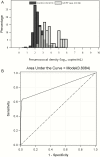Evaluation of Pneumococcal Load in Blood by Polymerase Chain Reaction for the Diagnosis of Pneumococcal Pneumonia in Young Children in the PERCH Study
- PMID: 28575374
- PMCID: PMC5447847
- DOI: 10.1093/cid/cix149
Evaluation of Pneumococcal Load in Blood by Polymerase Chain Reaction for the Diagnosis of Pneumococcal Pneumonia in Young Children in the PERCH Study
Abstract
Background.: Detection of pneumococcus by lytA polymerase chain reaction (PCR) in blood had poor diagnostic accuracy for diagnosing pneumococcal pneumonia in children in 9 African and Asian sites. We assessed the value of blood lytA quantification in diagnosing pneumococcal pneumonia.
Methods.: The Pneumonia Etiology Research for Child Health (PERCH) case-control study tested whole blood by PCR for pneumococcus in children aged 1-59 months hospitalized with signs of pneumonia and in age-frequency matched community controls. The distribution of load among PCR-positive participants was compared between microbiologically confirmed pneumococcal pneumonia (MCPP) cases, cases confirmed for nonpneumococcal pathogens, nonconfirmed cases, and controls. Receiver operating characteristic analyses determined the "optimal threshold" that distinguished MCPP cases from controls.
Results.: Load was available for 290 of 291 cases with pneumococcal PCR detected in blood and 273 of 273 controls. Load was higher in MCPP cases than controls (median, 4.0 × 103 vs 0.19 × 103 copies/mL), but overlapped substantially (range, 0.16-989.9 × 103 copies/mL and 0.01-551.9 × 103 copies/mL, respectively). The proportion with high load (≥2.2 log10 copies/mL) was 62.5% among MCPP cases, 4.3% among nonconfirmed cases, 9.3% among cases confirmed for a nonpneumococcal pathogen, and 3.1% among controls. Pneumococcal load in blood was not associated with respiratory tract illness in controls (P = .32). High blood pneumococcal load was associated with alveolar consolidation on chest radiograph in nonconfirmed cases, and with high (>6.9 log10 copies/mL) nasopharyngeal/oropharyngeal load and C-reactive protein ≥40 mg/L (both P < .01) in nonconfirmed cases but not controls.
Conclusions.: Quantitative pneumococcal PCR in blood has limited diagnostic utility for identifying pneumococcal pneumonia in individual children, but may be informative in epidemiological studies.
Keywords: PCR; blood; diagnosis.; pneumococcus; pneumonia.
© The Author 2017. Published by Oxford University Press for the Infectious Diseases Society of America.
Figures



References
-
- Werno AM, Anderson TP, Murdoch DR. Association between pneumococcal load and disease severity in adults with pneumonia. J Med Microbiol 2012; 61:1129–35. - PubMed
-
- Sullivan TD, LaScolea LJ, Jr, Neter E. Relationship between the magnitude of bacteremia in children and the clinical disease. Pediatrics 1982; 69:699–702. - PubMed
Publication types
MeSH terms
Substances
Grants and funding
LinkOut - more resources
Full Text Sources
Other Literature Sources
Molecular Biology Databases
Research Materials

